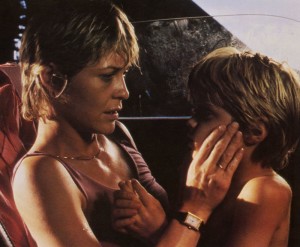One of my earliest childhood memories was my mother’s obsession with the writings of horror novelist Stephen King. As a small child in the ’80s, I remember going into the library room of the house to scare myself by pulling out the King books and looking at the covers. Next to the haunted symbol clashing monkey on the cover of “Skeleton Crew,” the cover of the book “Cujo“ was equally frightening.
The image depicted the snarling snout of the rabit titular hound emerging from a foggy setting. Terrifying to a five year old who loved the family dog, and enough to host half a dozen nightmares and just as many nights sleeping with the hall light on.
In 1983, a movie based on the book was released. Whether or not you’ve read the novel (of which I have not) you certainly know what the name Cujo represents. In thirty plus years since its release it has come to be synonymous with any wild, unfriendly, dangerous, or naughty canine.
Those unaware with the story identify it with the simplicity of its surface; Cujo goes berserk from the rabies virus (hes not just a dog, he a giant 250 pound St Bernard so the threat is valid) terrorizing a rural farmhouse. But like all of King’s works, the themes run much deeper than that.

The story (which King himself claims to have no recollection of writing due to his rampant alcoholism) contains many facets that add to the slow and mounting tension. The simple idea of man’s best friend turning on you is powerful in its own right. Factored in are the sins of adultery and the sacrifice of trust. Not only is Trenton family matriarch Donna (Dee Wallace) cheating on her husband Vic (Daniel Hugh-Kelly), she’s doing it with his best friend (Christopher Stone) a sloppy looking fellow she references at one point as the “town stud” (If I were to live there I’d be an Adonis). Whether intentional or not, King includes the perils of alcohol as well, a common theme amongst the characters in his stories (the most infamous being Jack Torrance in “The Shining.”)
Like King’s “Stand by Me,” “Cujo” has creepy undertones that keep the tension and chills going throughout, even without the specific danger of the rabid mutt being present. The opening scene where Cujo falls victim to a diseased bat is downright spooky, as is the performance of six year old Danny Pintauro as Tad Trenton. Pintauro would use his role in “Cujo” to launch into a staring role in the television series Who’s the Boss. Pintauro plays a somewhat annoying character, but is perfect as an overly imaginative child afraid of his dark closet at night. “There’s no such things as real monsters.” Vic reassures his son when he awakes from a nightmare. “Really?” “Really.”
Director Lewis Teague – who also worked on another of King’s projects; Cat’s Eye, does a great job considering the limitations of the story. The entire premise wouldn’t work today. It’s highly doubtful that a mother and son would become trapped in a dead Pinto, without the benefit of cell phones to immediately call for help.
The thought of being stranded in a hot car that’s flanked by a huge dog is terrifying. And most dogs nowadays have been vaccinated against rabies. Nevertheless, Teague shows the effects of the bat bite as Cujo is slowly driven to madness and eventually complete possession. You sit and watch, knowing what is going to happen and waiting on edge.
“Cujo” is a simple horror tale. It’s a decent watch and a solid story though it probably won’t scare anyone over the age of ten – not nearly as much as the cover of the book once did.
by – Matt Christopher